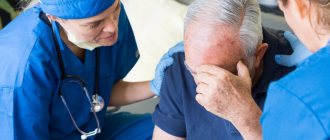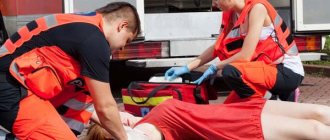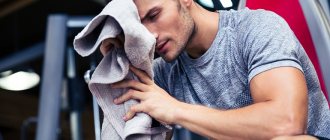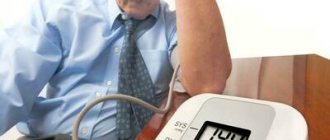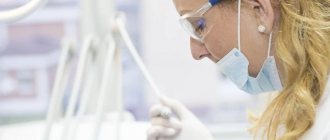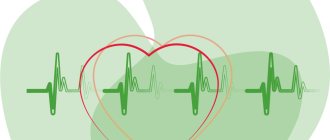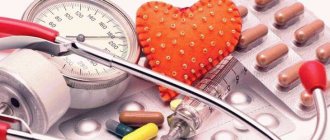The term stroke is understood as an acute disorder of cerebral circulation with a persistent decrease or complete loss of certain body functions. A stroke can be a focal stroke (micro-stroke) or extensive, in which paresis can occur, most often of one half of the body. A condition in which a person experiences weakness or complete lack of movement in the left or right half of the body is called hemiparesis. Paralysis of the left side or paralysis of the right side during a stroke often occurs as a result of rupture of a cerebral artery, if qualified help is not sought in a timely manner.
Etiopathogenesis
If the patient is paralyzed, then a stroke (hemorrhage) has occurred. Violation of the integrity of the arterial wall leads to the formation of a hematoma. As blood accumulates outside the vessel, it begins to put pressure on neighboring brain structures. Under these conditions, nerve cells responsible for key brain functions, such as muscle control, die, causing entire parts of the body to go numb.
A stroke with paralysis of the right side can be caused by the following factors:
- Wrong diet. It is very important to monitor the amount of calcium in the foods you eat, as it is a key element in maintaining the health of arterial walls. A lack of calcium leads to weakening of blood vessels and increases the risk of their damage. In this case, even small blood congestions can provoke hemorrhage.
- High blood pressure. Excessive blood pressure on the walls of the arteries can lead to their damage in the weakest places. As a rule, people at high risk are older people who experience deterioration in the elasticity of the vascular walls due to natural aging and low calcium levels.
- Hereditary predisposition. Recently, it was found that patients with a family history of stroke are likely to have a heart attack or stroke at some point in their lives. These are mainly patients with hypertension. While the specific inherited cause of the disease has not yet been established, it may be weak blood vessels and problems with neurohumoral regulation.
- Excess weight. Fat people tend to have low levels of minerals in the blood and high blood pressure - leading causes of stroke, which can paralyze the body.
- Diseases of the cardiovascular system. Impaired blood flow and rupture of a vessel in the brain can provoke pathologies such as heart defects, heart failure, the formation of atherosclerotic plaques and blood clots.
- Endocrine diseases. The most common cause of stroke among this group of pathologies is diabetes. People with this condition often suffer from high blood pressure. Also at risk are patients with low levels of thyroid hormones and problems in the adrenal cortex.
- Alcohol and tobacco abuse. Nicotine reduces the strength of arterial walls and increases cholesterol levels in the blood. High-quality alcoholic drinks in small quantities can even be beneficial, but frequent and excessive consumption of alcohol easily provokes hemorrhage with subsequent paralysis.
The causes of paralysis of both the right and left parts of the body are indicated above. Statistics show that bad habits are the most common factor in paralysis, in which it is much more likely to help the patient survive if diagnosed in time.
Types of paralysis
When a person is admitted to hospital with a stroke, it is important to determine from the outset whether they have paralysis and what its nature is. Paralysis in all parts of the body (left and right sides) is divided into 2 groups.
- Peripheral paralysis. This is a milder form of the disorder, accompanied by selective loss of body function. In this case, motor nerve cells are damaged, numbness occurs, and the person cannot perform complex actions.
- Central paralysis. This condition is associated with the formation of a hematoma in the areas of the brain responsible for movement. This causes complete paralysis of the right leg or arm. Such patients lose the ability to self-care and may remain disabled for life.
How to recognize paralysis on the right side?
When a stroke occurs in the left hemisphere of the brain, the right side is usually affected, the muscles of the legs and arms are paralyzed, and speech is lost. Such symptoms allow us to say with confidence that the patient has right-sided paralysis. In addition, additional symptoms are noted.
- The main signs of a stroke are sudden fatigue, severe headache, nausea and vomiting. These symptoms are observed in the patient on the first and second days after the attack and are characteristic behavior of the body when brain cells die.
- Immobilization. If the central part of the brain is damaged, the right leg and arm cease to obey, become numb and sag. If the peripheral nerve cells are damaged, the right side of the body begins to tremble, and the patient cannot perform certain actions, but overall mobility is maintained.
- Memory impairment. It is difficult for the patient to repeat several phrases at once. With a serious disorder, the patient instantly forgets even one word.
- Disruption of the right facial nerve - this leads to loss of control over the muscles of the entire right side of the face, and the ability to make facial expressions is lost. As a result, the right side of the mouth and eyelid droop down.
- The skeletal muscles of the right side of the body contract in any direction. As a rule, the arm bends at the elbow, the leg straightens, and the foot turns toward the center.
The above symptoms appear within minutes after a stroke. Due to disruption of the functioning of different parts of the body, the patient experiences a stressful state, which can lead to nervous breakdown and rejection of social contacts.
First aid for left-sided ischemic stroke
First of all, you should call and clearly explain to him what happened to the patient, list all the symptoms. After which, a team will come to you for transportation to the Yusupov Hospital, which will necessarily include a neurologist.
During the waiting period, it is necessary to provide first aid to the patient on your own. First aid for a stroke has basic rules that must be followed:
- the victim’s head should be raised 30 degrees, which can be achieved with the help of a low pillow, blanket, clothing, etc.;
- the patient must be provided with access to fresh air - it is necessary to open the windows and doors in the room;
- you need to loosen or remove all squeezing objects: belts, waistbands, collars, etc.;
- when vomiting, it is necessary to prevent the victim from choking on vomit by turning his head to the side, and then help him rinse his mouth;
- It is necessary to constantly monitor blood pressure, recording the results.
After transporting the patient to the hospital, the best neurologists at the Yusupov Hospital will conduct the necessary diagnostic tests and provide subsequent assistance - medicinal or surgical.
What does paralysis of the right side entail?
If the left hemisphere is seriously damaged, the patient may be paralyzed for the rest of his life. Permanent disability is the result of a large hematoma in the brain or improper treatment. Let's look at a few common complications:
- paralysis of all limbs;
- irreversible speech impairment;
- deterioration of cognitive functions, including thinking abilities, memory, interaction with society;
- formation of bedsores;
- worsening of existing chronic diseases due to loss of mobility;
- problems with holding urine and feces.
To recover from a stroke on the right side, treatment is selected that will help reduce the risk of such conditions.
Treatment
Therapy after a stroke helps restore normal blood flow to the damaged area of the brain and reduce the risk of developing vascular problems and having another stroke. The patient may be prescribed a complex of medications and folk remedies.
Drug therapy
If the right side of the body is paralyzed after a stroke, the doctor first prescribes medications.
- Anticoagulants and antiplatelet agents (for example, Warfarin and Curantil) - prevent the formation of blood clots, making it more fluid, which improves blood flow even through the narrowest sections of blood vessels. These drugs help improve the condition of patients with atherosclerosis, blood clots, or narrowed blood vessels.
- Agnioprotectors (“Alprostan”, “Parmidin”) - normalize the functioning of the walls of blood vessels, reducing the risk of reducing the lumen in the arteries.
- Antispasmodic drugs (such as Vincamine and Papaverine) help relax the vascular walls, which increases blood flow.
- Diuretics (“Veroshpiron”, “Hypothiazide”) - help remove excess fluid from the body, reducing the risk of developing cerebral edema and exacerbation of hypertension.
- Nootropics (“Actovegin”, “Piracetam”) - increase brain performance. Nootropics are prescribed throughout recovery and for some time after full recovery.
Drug therapy is selected individually, based on the diagnosis and the general health of the patient. In case of serious disorders, the patient is given all types of medications and his blood pressure is monitored.
Folk remedies
Traditional medicine provides additional assistance in recovery and is prescribed along with basic medications. In case of serious health problems, consultation with a specialist is necessary to draw up a specific treatment and preventive program.
Let's consider the most effective folk remedies.
- Taking a bath with the medicinal plant oregano. First you need to boil water along with the herb in the proportion of a liter per spoon and then pour it into the bath. For an average bath, 5 or 6 liters of decoction is enough.
- Honey and propolis are thoroughly mixed in a vessel with a ratio of 100 to 1, after which they are left to infuse for three days. The finished product is taken a couple of drops twice a day.
Folk remedies help improve blood flow and supply brain tissue with essential nutrients, as well as improve the functioning of the immune system.
Diagnosis of ischemic stroke
If an ischemic stroke is suspected at the Yusupov Hospital, the patient undergoes laboratory tests and is examined using instrumental methods using modern equipment from leading companies in Europe, the USA and Japan. The results of the examination allow us to make an accurate diagnosis and prescribe adequate therapy. In order to determine the type of stroke and determine whether the left or right side of the brain is affected, computed tomography or magnetic resonance imaging is performed. Immediately after neuroimaging of a stroke, the following studies are performed:
- electrocardiography;
- ultrasonography;
- blood tests.
The patient is then examined by an ophthalmologist and an endocrinologist. Later, additional diagnostic procedures are performed:
- X-ray of the skull;
- chest x-ray;
- electroencephalogram;
- echocardiography.
After an accurate diagnosis is made, treatment for ischemic stroke is prescribed.
Rehabilitation
The main goal of rehabilitation after a stroke is the return of movements in the right side of the body, speech and other cognitive abilities. First of all, the patient is recommended to follow a certain diet, go to massage, physiotherapy and consult a speech therapist.
Diet
In order for blood flow and other body systems to recover faster, you need to limit yourself to certain foods and focus on healthier foods. The body must receive all the necessary substances with food to restore damaged tissues.
dieta-after-insulta
When preparing a diet, you should adhere to a number of conditions:
- do not eat smoked meats or foods high in fat;
- meat products should be consumed lean, in small quantities (preferably in crushed form) and only after consultation with a doctor;
- eat more fresh fruits and vegetables;
- do not drink drinks high in caffeine, sugar or alcohol;
- eat food often, but in small quantities.
In case of serious consequences of a stroke, the products should be selected by a nutritionist, taking into account the patient’s health and level of energy consumption.
Massage
Massage is necessary to prevent the formation of bedsores, so it is prescribed from the very beginning on a daily basis. During the procedure, the entire right side of the body is warmed up. This helps normalize blood flow, molecular processes in cells and joint functions.
Therapeutic massage of the paralyzed part includes:
- stroking the body from the limbs towards the blood flow;
- rubbing the skin is carried out in the same direction, but more actively;
- creating vibration in the softest places;
- repeated stroking at the end of the session.
You can avoid the development of bedsores if you carry out similar actions every day. It is also important to frequently shift the patient, changing his position, and rub with alcohol (if there are no skin disorders).
Physiotherapy
Physical therapy is prescribed after 2 or 3 weeks from the moment of the stroke, if the patient is clearly on the mend. Physical education is prescribed to achieve a number of goals:
- reducing the risk of muscle atrophy;
- increasing the ability of nerve tissue to transmit impulses to muscles;
- regaining the ability to control the body and take care of oneself independently.
lechebnaya-fizkultura
The most effective physical therapy is prepared by a specialist who can select exercises to restore certain abilities.
Consequences of left-sided ischemic stroke
A patient who has suffered a stroke in the right hemisphere has a distorted image of his body, he does not feel motor disturbances and, therefore, does not strive for recovery. Such indifference makes rehabilitation difficult and requires referral to qualified specialists.
At the Yusupov Hospital, highly qualified doctors will select and implement an effective rehabilitation program after left-sided ischemic stroke. The program includes activities aimed at restoring the motor system and psycho-emotional state of the patient. Rehabilitation is based on classical and latest recovery techniques. Patients undergo massage, mechanotherapy, electrical stimulation, kinesthetics, diet and herbal therapy.
The Neurology Clinic of the Yusupov Hospital combines the advanced achievements of rehabilitation medicine and a homely atmosphere, thanks to which patients feel the care and attention of medical personnel and receive the necessary assistance from highly qualified specialists.

